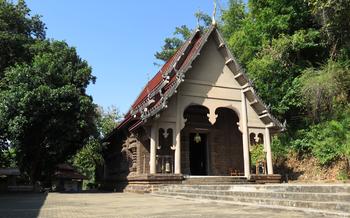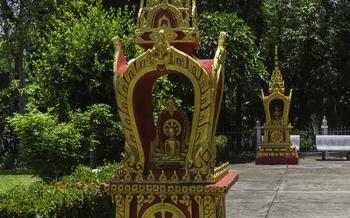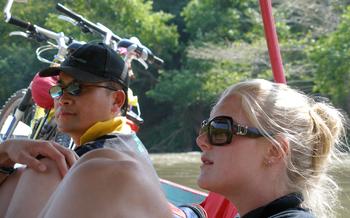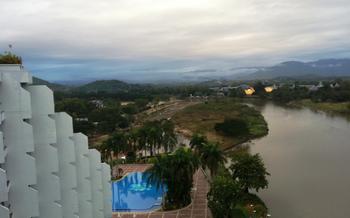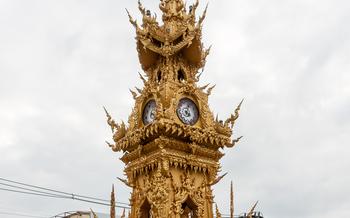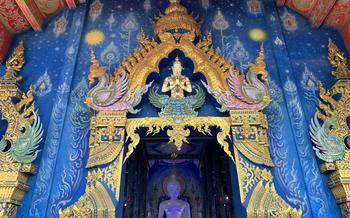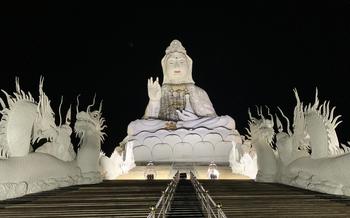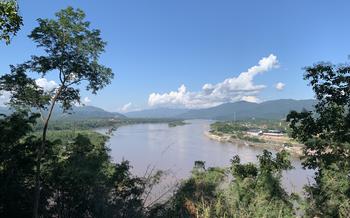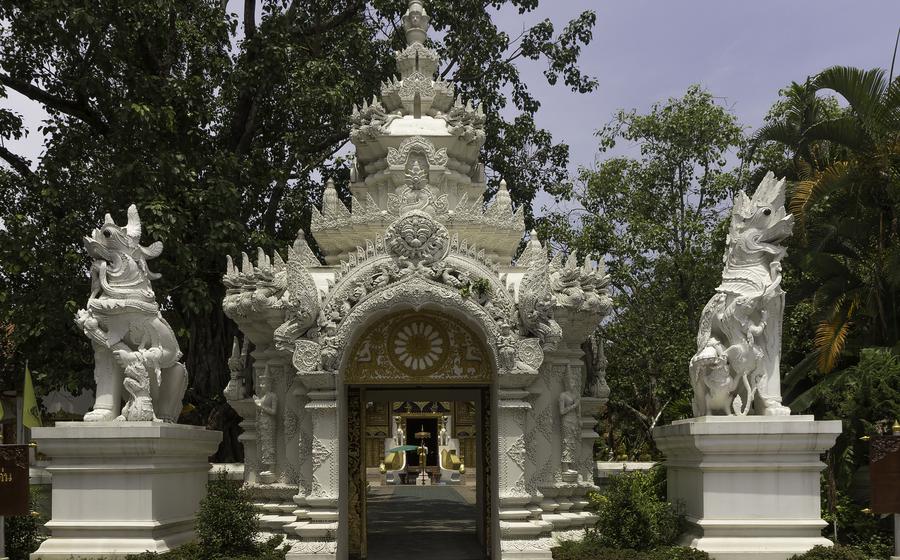
Mae Chan Hot Springs
- Mae Chan Hot Springs: A Relaxing Retreat in Chiang Rai
- Getting to Mae Chan Hot Springs
- Facilities and Amenities
- Soaking in the Hot Springs
- Exploring the Surroundings
- Trying Local Cuisine
- Elephant Sanctuary
- Ziplining and ATV Rides
- Hill Tribe Villages
- Wat Rong Khun (White Temple)
- Singha Park
- Doi Mae Salong
- Insider Tips for an Enriching Experience
Mae Chan Hot Springs: A Relaxing Retreat in Chiang Rai
Nestled in the lush countryside of Chiang Rai, Thailand, the Mae Chan Hot Springs offer a tranquil oasis for relaxation and rejuvenation. Steeped in history and surrounded by breathtaking natural beauty, these hot springs have been revered for centuries for their therapeutic properties and restorative powers. Visitors can immerse themselves in the warm, mineral-rich waters, soak away their stress, and reconnect with nature's tranquility. With an abundance of activities to choose from, including hiking, birdwatching, and exploring nearby temples, the Mae Chan Hot Springs promise an unforgettable experience for travelers seeking a truly relaxing and revitalizing getaway.
Getting to Mae Chan Hot Springs
The Mae Chan Hot Springs are situated approximately 65 kilometers north of Chiang Rai city, nestled amidst the lush countryside. Visitors can conveniently reach the hot springs by car, which takes about 1 hour and 30 minutes, or by hiring a private taxi or tuk-tuk. The approximate cost of a one-way taxi ride from Chiang Rai to the hot springs ranges between 1,000 and 1,500 Baht.
For those who prefer a more leisurely journey, there are also several public transportation options available. Visitors can catch a local bus from Chiang Rai's Arcade Bus Station, which takes approximately 2 hours and costs around 100 Baht. Alternatively, songthaews (shared taxis) are a popular choice, departing from the Old Bus Station in Chiang Rai and charging around 50 Baht per person.
To reach the hot springs by car, follow Highway 1020 north from Chiang Rai towards Mae Chan. After passing through the town of Mae Chan, continue for another 10 kilometers until you see signs for the hot springs. Turn right onto a narrow road and follow it for about 2 kilometers until you reach the entrance of the hot springs.
Facilities and Amenities
Mae Chan Hot Springs offers a range of facilities and amenities to enhance the visitor experience. For those seeking a comfortable stay, the area boasts a selection of hotels, resorts, and guesthouses that cater to different budgets and preferences. Accommodation options range from basic guesthouses to luxurious resorts with private hot spring pools.
When it comes to dining, visitors have a variety of options to choose from. Restaurants and cafes serving both Thai and international cuisine are abundant, offering a tantalizing array of culinary delights. Local specialties such as khao soi, a northern Thai curry noodle soup, and sai ua, a grilled pork sausage, are must-try dishes. Vegetarian and vegan options are also available for those with dietary restrictions.
For those who wish to indulge in a shopping spree, the hot springs area offers a vibrant market where visitors can find a variety of local handicrafts, souvenirs, and textiles. Bargaining is expected and is part of the local culture, so don't be afraid to haggle for a good price.
To ensure the comfort and convenience of visitors, the hot springs complex is equipped with changing rooms and lockers, allowing guests to store their belongings safely while enjoying the hot springs.
Soaking in the Hot Springs
The Mae Chan Hot Springs offer a unique and rejuvenating experience for visitors. The water temperature averages between 104°F (40°C) and 113°F (45°C) and is rich in minerals such as sulfur, calcium, and magnesium. Bathing in these waters is believed to have several health benefits, including improved circulation, relief from muscle pain, and reduced stress.
When using the hot springs, it is important to follow proper etiquette to ensure the safety and comfort of everyone. First, always test the water temperature before entering, as it can vary depending on the time of day and weather conditions. Second, avoid wearing jewelry or other accessories that could get damaged by the minerals in the water. Third, be respectful of other bathers and maintain a quiet and peaceful environment.
The duration of each soak should be limited to 15-20 minutes to avoid overheating and dehydration. It is recommended to take breaks in between soaks to cool down and rehydrate. Additionally, it is important to drink plenty of water before, during, and after your visit to stay hydrated.
Exploring the Surroundings
The Mae Chan Hot Springs is surrounded by a wealth of natural beauty and cultural attractions. Visitors can embark on a variety of activities to explore the stunning surroundings.
For nature enthusiasts, the area boasts a network of well-maintained hiking trails and nature walks. These trails wind through lush forests, offering breathtaking views of the surrounding mountains and valleys. Hikers can encounter a wide array of flora and fauna, including exotic birds, colorful butterflies, and playful monkeys.
Birdwatchers will be delighted by the diversity of avian species that call the area home. The hot springs are a popular spot for birdwatching, with a variety of migratory and resident birds that can be spotted throughout the year.
Visitors can also explore the nearby temples and villages to gain a deeper understanding of the local culture and way of life. The village of Mae Chan is home to several temples, including the historic Wat Mae Chan and the beautiful Wat Phra That Mae Chan. These temples offer a glimpse into the religious and cultural heritage of the region.
For a unique experience, visitors can take a boat ride on the Mae Chan River. The river meanders through the lush countryside, offering picturesque views of the surrounding scenery. Along the way, visitors may spot local fishermen casting their nets or farmers tending to their fields.
Trying Local Cuisine
Indulge in the tantalizing flavors of northern Thai cuisine during your visit to Mae Chan Hot Springs. Khao soi, a rich and creamy curry noodle soup, is a must-try dish, known for its unique blend of spices and coconut milk. Sai ua, a grilled sausage made with pork, lemongrass, and kaffir lime leaves, is another local delicacy not to be missed. For a refreshing treat, mango sticky rice is a popular choice, featuring sweet, ripe mangoes served with glutinous rice and coconut cream.
Where to Eat:
-
Mae Chan Night Market: A vibrant market with a wide variety of street food stalls, offering local delicacies at affordable prices.
-
Rim Nam Restaurant: Located by the Mae Chan River, this restaurant serves authentic Thai dishes with a beautiful riverside view.
-
Khao Soi Mae Sai: A renowned restaurant specializing in khao soi, with a variety of options to choose from.
Vegetarian and Vegan Options:
-
Green Garden Restaurant: A vegetarian and vegan restaurant offering a range of healthy and flavorful dishes, made with fresh, local ingredients.
-
The Hive Vegan Cafe: A cozy cafe serving delicious vegan food, including smoothies, salads, and desserts.
Cooking Classes and Food Tours:
-
Mae Chan Cooking Class: Learn to cook traditional Thai dishes in a hands-on cooking class, using local ingredients and traditional techniques.
-
Taste of Chiang Rai Food Tour: Embark on a culinary adventure with a guided food tour, exploring the best street food spots and local markets in Chiang Rai.
Elephant Sanctuary
Just a short drive from Mae Chan Hot Springs, visitors can immerse themselves in the unique experience of an elephant sanctuary. This ethical haven provides a safe and nurturing environment for rescued elephants, prioritizing their well-being and conservation. Visitors can engage in various activities that promote interaction and understanding of these gentle giants.
Elephant feeding sessions allow visitors to contribute to the elephants' care while observing their natural behaviors up close. Bathing the elephants is another unforgettable experience, where visitors can assist in cleaning and caring for these magnificent creatures while creating a special bond. For a truly immersive encounter, visitors can embark on an elephant trekking adventure, exploring the surrounding jungle trails while riding on the elephants' backs.
The sanctuary's knowledgeable guides provide insights into elephant behavior, conservation efforts, and the importance of preserving their natural habitat. Visitors leave with a newfound appreciation for these majestic animals, understanding the crucial role they play in the delicate balance of the ecosystem.
Ziplining and ATV Rides
For adrenaline seekers and nature enthusiasts, Mae Chan Hot Springs offers a variety of exciting activities to complement the relaxing hot springs experience. The surrounding jungle terrain provides an ideal setting for ziplining and ATV rides, allowing visitors to explore the area from unique perspectives.
The zipline courses are designed for different skill levels, catering to both beginners and experienced adventurers. Safety measures are taken seriously, with trained instructors providing thorough briefings and ensuring that all participants are properly equipped with harnesses and helmets. Soaring through the jungle canopy, visitors can enjoy breathtaking views of the lush vegetation and the winding Mae Chan River below.
ATV rides offer another exhilarating way to explore the jungle trails. Off-road enthusiasts can rent ATVs and embark on guided tours or self-drive adventures through the rugged terrain. These rides provide an adrenaline rush as riders navigate through muddy paths, rocky streams, and dense forests, while also offering a chance to encounter wildlife and admire the natural beauty of the surroundings.
The cost of each activity varies depending on the duration and the specific package chosen. Visitors can inquire about prices and book their preferred activities at the tour operators' offices located near the hot springs. Prior reservations are recommended, especially during peak season, to secure a spot and avoid disappointment.
Hill Tribe Villages
Nestled in the mountainous regions surrounding Chiang Rai, the hill tribe villages offer a glimpse into the rich cultural heritage of the region. The Akha, Hmong, Lisu, and Karen are among the most prominent hill tribes, each with their unique traditions, costumes, and languages.
Visiting these villages is an opportunity to interact with the locals, learn about their way of life, and support their livelihoods. You can witness traditional dances and music performances, sample local cuisine, and purchase handmade crafts and souvenirs.
When visiting hill tribe villages, it is important to be respectful of local customs and traditions. Dress modestly, ask permission before entering homes or taking photos, and be mindful of your behavior.
Some popular hill tribe villages to visit near Chiang Rai include:
- Akha Village: Located about 40 kilometers from Chiang Rai city, the Akha Village is known for its colorful costumes and intricate silver jewelry.
- Hmong Village: Situated near Doi Mae Salong, the Hmong Village offers stunning views of the surrounding mountains and tea plantations.
- Lisu Village: The Lisu Village, located about 60 kilometers from Chiang Rai, is known for its traditional bamboo houses and rice terraces.
- Karen Village: The Karen Village, nestled near the Mae Kok River, is famous for its long-necked women, who wear brass rings around their necks to elongate them.
Wat Rong Khun (White Temple)
Located about 30 kilometers from Mae Chan Hot Springs, Wat Rong Khun is an extraordinary temple that has gained international acclaim for its unique architectural style and design. This stunning temple is the brainchild of renowned Thai artist Chalermchai Kositpipat, who began its construction in 199The temple's exterior is adorned with intricate carvings and sculptures, featuring mythical creatures, Buddhist deities, and scenes from modern life, all rendered in a striking white color.
Inside the temple, visitors are greeted by a majestic Buddha statue surrounded by vibrant murals depicting scenes from Buddhist cosmology and Thai history. Chalermchai Kositpipat's unique artistic vision is evident in every detail of the temple, from the shimmering mosaics to the surreal sculptures that adorn the grounds.
When visiting Wat Rong Khun, it's essential to dress respectfully, covering your shoulders and knees. Removing shoes is also required before entering the temple's main hall. Visitors should be mindful of their behavior, maintaining silence and refraining from touching the temple's structures.
Wat Rong Khun is not only a spiritual sanctuary but also a testament to the creativity and artistry of Chalermchai Kositpipat. It offers visitors a unique and awe-inspiring experience, blending traditional Buddhist iconography with contemporary artistic expression.
Singha Park
Nestled in the picturesque Mae Taeng Valley, approximately 50 kilometers from Chiang Rai city, lies Singha Park, a sprawling 8,000-acre estate that seamlessly blends nature, culture, and adventure. Once a tobacco plantation, this vast expanse has been transformed into a multifaceted leisure destination, offering a myriad of attractions for visitors of all ages.
Enter the park, and you are greeted by lush greenery, tranquil ponds, and meticulously landscaped gardens, creating a serene oasis away from the city's hustle and bustle. At the heart of the park lies the Singha Beer Brewery, a state-of-the-art facility that produces Thailand's iconic lager. Visitors can embark on guided tours of the brewery, gaining insights into the brewing process and sampling the freshly produced beer.
For those seeking adventure, Singha Park offers a range of thrilling activities. Take a ride on the exhilarating zipline course, soaring through the treetops and enjoying breathtaking views of the surrounding countryside. Alternatively, embark on an ATV ride, traversing rugged jungle trails and discovering hidden corners of the park.
History buffs will appreciate the park's historical significance. It was here, in the 1930s, that the Boonrawd Brewery, the forerunner of Singha Corporation, was established by the visionary Khun Boonrawd. This pioneering spirit continues to permeate the park, with its commitment to sustainability and innovation.
Admission to Singha Park is reasonably priced, and visitors can choose from various ticket options depending on the activities they wish to experience. Advance booking is recommended, especially during peak tourist season, to avoid disappointment.
Whether you are seeking relaxation, adventure, or a glimpse into Thailand's rich brewing heritage, Singha Park promises an unforgettable experience for every visitor.
Doi Mae Salong
Nestled amidst the lush mountains of Chiang Rai, Doi Mae Salong is a captivating destination that blends natural beauty with cultural diversity. The mountain is renowned for its sprawling tea plantations, which cascade down the slopes like a green tapestry. Visitors can embark on scenic hikes through the plantations, marveling at the verdant vistas and the delicate aroma of tea leaves in the air.
Several viewpoints along the trails offer breathtaking panoramas of the surrounding landscape, allowing visitors to capture the essence of this enchanting region. Doi Mae Salong is also home to a diverse array of ethnic groups, including Chinese, Shan, and Akha. Each community has its own unique traditions, customs, and cuisine, creating a vibrant cultural tapestry that is unlike anything else in Thailand.
Visitors can interact with the locals, learn about their way of life, and sample their delicious regional dishes. The mountain's cultural heritage is further showcased in its numerous temples and villages, where visitors can gain insights into the beliefs and practices of the local people.
Whether you're seeking scenic beauty, cultural immersion, or simply a chance to relax and unwind, Doi Mae Salong offers an unforgettable experience that will leave you feeling refreshed and inspired.
Insider Tips for an Enriching Experience
To make the most of your visit to Mae Chan Hot Springs, consider these insider tips:
-
Best time to visit: Aim for the shoulder seasons (April-May and September-October) to avoid the peak tourist crowds and enjoy pleasant weather.
-
Packing essentials: Bring comfortable clothing, a swimsuit, a towel, and sturdy shoes for exploring the surroundings. Don't forget your camera to capture the stunning scenery.
-
Local customs and etiquette: Respect the local culture by dressing modestly and behaving respectfully. Always ask permission before taking photos of people or sacred sites.
-
Hidden gem spots: Venture off the beaten path to discover hidden gems like the nearby Mae Chan Waterfall or the secluded hot springs in the jungle. Ask locals for recommendations.

